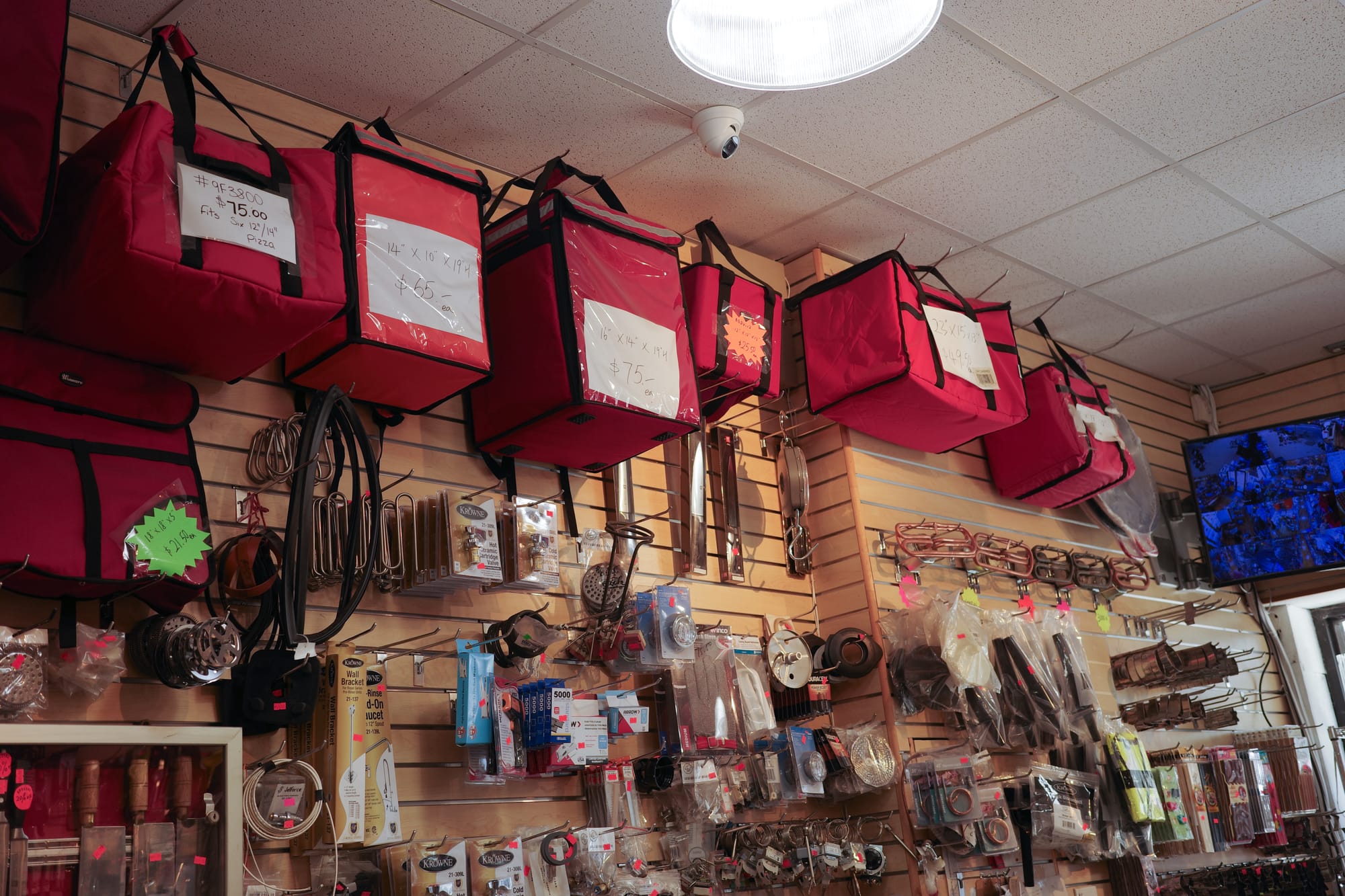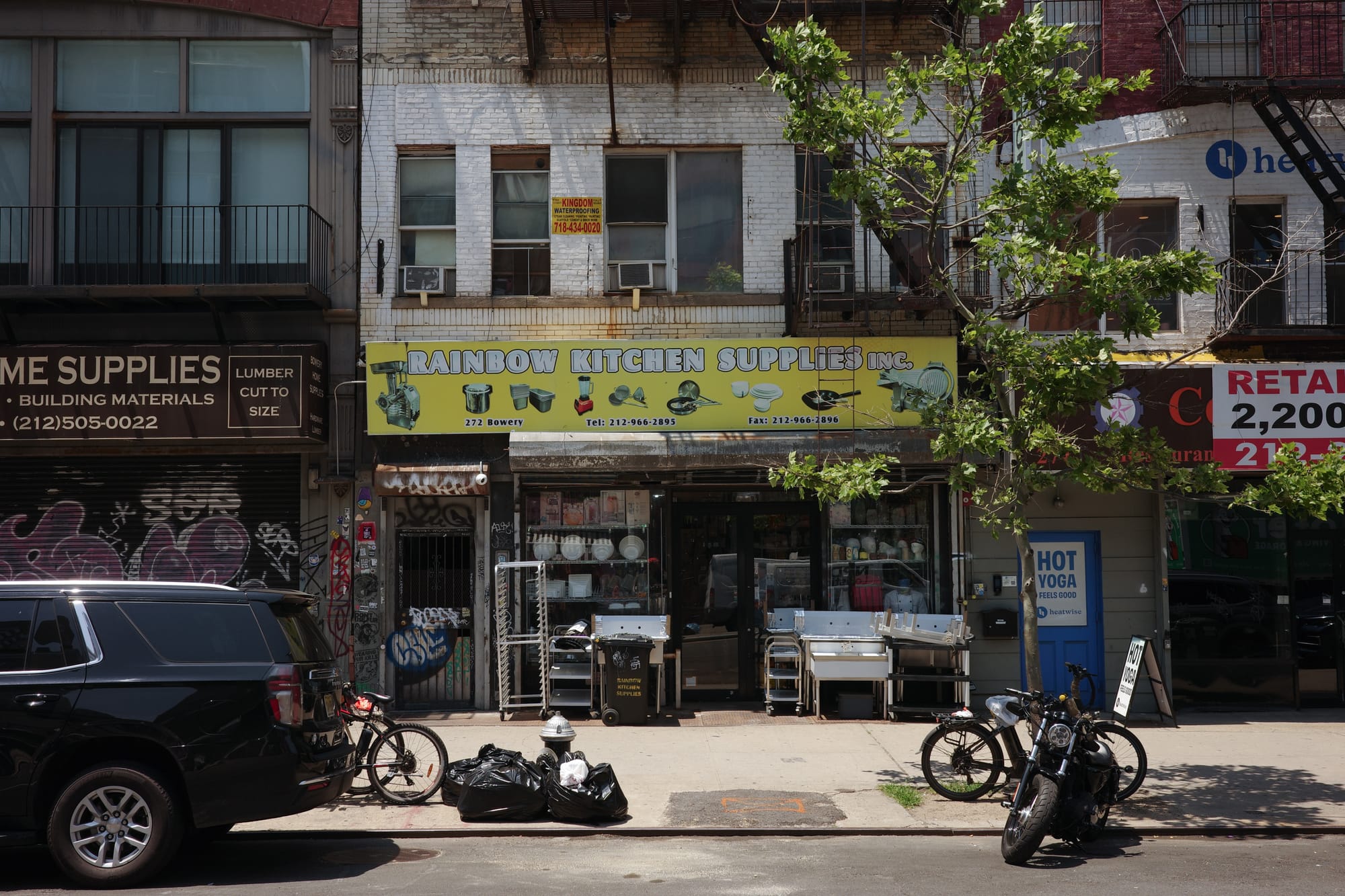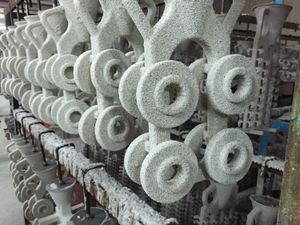The first store that Nicola Twilley and I visit does not sell refrigerators. We are on the Bowery, a neighborhood known mostly for flophouses and restaurant supply stores, and we are looking for refrigerators. We are looking for refrigerators because Nicola is a refrigeration nerd, and her book about refrigeration is coming out on Monday, and it’s everything I’ve been waiting for. I am very excited to see some refrigerators with her.
While the first store we visit does not sell refrigerators, they do still sell parts of the cold chain: insulated delivery bags, used by couriers across New York City to deliver both hot and cold food to anyone willing to pay for it. We both look up at these rectangular, red bags — shapes that are deeply familiar to anyone who lives in an urban environment in 2024, and which represent the final step in a complex system that, as Nicola explains in Frostbite, overturned millennia of dietary history. “The cold chain becomes more and more ad hoc the closer you get to the consumer,” Nicola tells me, gesturing towards the delivery bags' hand-lettered, packing-taped price tags. We’ve both slipped partially into shopping mode, browsing through the fry baskets and cocktail glasses and quaternary ammonium compound test strips on display. “In some places the cold chain is highly regulated — and then here it’s a dude with an insulated bag on his back.”

We are, it strikes me, strolling through a key node in one of New York City’s most critical and notable life support systems. Nicola agrees: “The effort that it takes to feed everyone here is such a visible metabolic process, whereas in other cities it can happen out of sight, in the alley, wherever. New York City is just built in such a way that the refrigerated truck needs to park in the street; the trash has to pile up out front. The bringing in of the food, and the spewing out the other end, it’s all so much more visible than in other cities.”
We walk back out onto the street. I have traveled the Bowery countless times, and while I have never worked in a restaurant, I still know it definitively as Manhattan's restaurant supply district. “I don’t think cities could have gotten above a certain size without refrigeration,” Nicola says as we walk a few doors down and enter Roger & Sons Restaurant Equipment. “The feeding of a city—”
But now we’re inside, and Roger & Sons does have refrigerators, and Nicola tells the salesperson, Vincent, that we want to see them all. They sell mostly True (made in the US) and Entree (made in China). An average restaurant will need one or two of the one- or two-door units we’re looking at. They may also have an under-counter or salad-prep unit; both of these are refrigerators too. And then walk-ins, which they do a lot for bagel stores and restaurants. These are a custom installation, with a split refrigeration system. The chiller is mounted remotely like your home’s heat pump, and the walk-in refrigerator itself is just a very heavily insulated, partially prefabricated room. The assembly is a “pretty crazy process,” but done in two to three weeks, with an assembly crew putting together the insulated panels on-site.
At this point, Vincent asks if Nicola and I are building out a restaurant. We are not, we explain, we’re just here to talk about refrigeration, which she has written a book about. He’s game, and we go on to talk about ice cream shops, and the cost of restaurant refrigerators (one of the Trues next to us is $2,500; a small restaurant might easily spend ten grand on refrigeration; a walk-in could be twenty grand). Nicola asks about temperature control — do restaurant refrigerators have different compartments with different controls, like my crisper drawer? They do not; commercial refrigerators have a single cavity, which you can get things into and out of quickly. Do restaurant refrigerators have shelves on their doors, like my family uses for milk and condiments? They do not; their doors might be flung closed during a dinner rush, and it’s just better to have everything stored on a stationary shelf.

We thank Vincent and keep walking, past a storefront (closed, on a Friday at eleven-thirty) that apparently sells deli slicers. We walk to the end of the restaurant supply district, and turn around. It has been most of an hour, and I’m going back to my bike, which is parked around the corner in front of the Whole Foods. Nicola is going to the New York Public Library to try to find an old insurance map that might, or might not, show the location of the first cold storage warehouse in America. As we walk up to the Whole Foods ,Nicola peers into the window, wondering aloud suddenly where their cold storage is. “This is the hard part,” she says, “keeping the shelves filled at an urban supermarket like this. You don’t have any on-site storage, and if you start going upstairs and downstairs it gets expensive. Do not lift or lower,” she admonishes, “keep it all at ground level.”
Before we depart, Nicola gets a little philosophical. “Often what I’ve found, with the cold chain, is that once you have a hammer the whole world looks like a nail. People want to keep their bagel fresh, so they put it in the fridge, because they think this machine confers freshness. We could solve the problem of freshness one way or another, and the way we’ve chosen to solve it is by using the existing cold infrastructure.
“The thing I think is so interesting about refrigeration is that it’s been implemented almost entirely commercially. Unlike other infrastructure, there was never the equivalent of a federal freeway project; it’s a very commercial, ad hoc solution. It’s never been in the service of a grand vision, by someone thinking about how best to feed the city, or the best way to promote health, or economic outcomes, or sustainability, or our relationship to the land. Nobody has looked at refrigeration as a connected whole yet, and now would be a really good time to do that — as we build the cold chain everywhere else. I love refrigeration, but we’ve implemented this one technology, and it has had some effects. As the rest of the world builds their cold chain, I think there are some things to be learned from that.”
Right at the end of this last paragraph, both of our phones start wailing at us: Aftershock warnings from the largest earthquake in New York City in a hundred and forty years (it had struck right before we met up, but somehow neither of us felt it). We chat for another five minutes, tossing around the idea of refrigeration as a utility, and the potential perils of building an American-style cold chain around the rest of the world (“it would be terrible, terrible”). Then we touch base on her publication schedule, I reiterate how excited I am to talk with her and the Reading Group, and we depart.
SCOPE CREEP.
- On the excellent podcast she co-hosts, Gastropod, Nicola gives a preview of Frostbite and offers a few excellent anecdotes that she picked up during her many years of research into the cold chain.
- Spaces of Banana Control, which Nicola published in 2011 and which is also about the cold chain, is still maybe my favorite blog post about anything, ever.
- It's not about the cold chain, but Nicola's incredible 2016 New Yorker piece explains how the first gravitational waves were recorded at LIGO, a mind-bogglingly large observatory located partly in Washington state and partly in Louisiana.
Thanks as always to Scope of Work’s Members and Supporters for making this newsletter possible. A huge thanks to Nicola for looking at refrigerators with me, and for writing Frostbite, AND for agreeing to chat with the SOW Members' Reading Group in just a few weeks' time 💞
Love, Spencer.



